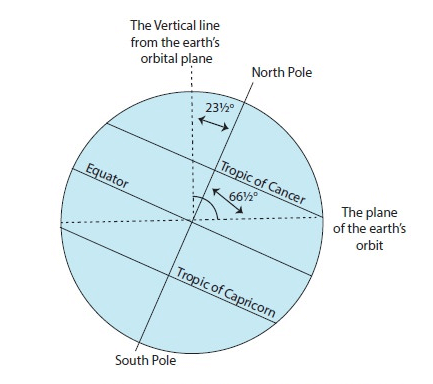Geography - Class 6
The Earth: Our Habitat
Chapter 3: Motions of the Earth
Question 1. Answer the following questions briefly.
- What is the angle of inclination of the earth’s axis with its orbital plane?
Answer: The angle of inclination of the earth's Axis with its orbital plane is 66^1/2°.
- Define rotation and revolution.
Answer: Rotation is the movement of the earth on its axis. The movement of the earth around the sun in a fixed path or orbit is called Revolution.
- What is a leap year?
Answer: A year that has 366 days instead of 365 days is called a leap year. Thus, every fourth year February has 29 days instead of 28 days.
- Differentiate between the Summer and Winter Solstice.
Answer:
Summer solstice Winter Solstice It is the time when the whole northern hemisphere experiences more heat and light. This is because the sun falls directly on the Tropic of Cancer. It is the time when the whole southern hemisphere experiences more heat and light. This is because the sun falls directly on the Tropic of Capricorn. At this time, the North pole is tilted towards the sun. At this time, the South pole is tilted towards the sun. Due to the large portion being tilted, it is summer in Northern Hemisphere. Due to the large portion being tilted, it is summer in Southern Hemisphere. Winter occurs in the Southern hemisphere. Summer occurs in the Northern hemisphere. It occurs on 21st June in Northern Hemisphere. It occurs on 22nd December in Southern Hemisphere. During this period, days are longer than nights in the Northern hemisphere. During this period nights are longer than days in the Northern hemisphere. - What is an equinox?
Answer: Equinox is the position of the Earth on 21st March and 23rd September when the whole Earth experience equal days and nights.
On these days, direct rays of the Sun fall on the equator and neither of the poles is tilted towards the sun that's why both the hemispheres experience equal days and equal night.
- Why does the Southern Hemisphere experience Winter and Summer Solstice in different times than that of the Northern Hemisphere?
Answer: The Southern Hemisphere experiences Winter and Summer Solstice at different times than that of the Northern Hemisphere because:
On 21st June, when the Northern Hemisphere is tilted towards the sun, the Southern Hemisphere of course will be away from it. This leads to North Hemisphere experiencing summer solstice while the Southern Hemisphere experiences winter solstice at the same time.
On 22nd December, when the Southern Hemisphere is tilted towards the sun the Northern Hemisphere will be away from it. Therefore, this results in Southern Hemisphere experiencing summer solstice while the Northern Hemisphere experiences winter solstice. - Why do the poles experience about six months day and six months night?
Answer: The poles experience about six months day and six months of the night because when the Northern Hemisphere tilts towards the sun, the North Pole is inclined towards the sun. This results in it experiencing light for the whole day. While the North Pole is in light the South Pole does not get light during this time. This phenomenon takes place for a period of six months.
The conditions are reversed with respect to the Southern Hemisphere.
Question 2. Tick the correct answer.
- The movement of the earth around the sun is known as
- Rotation
- Revolution
- Inclination
- Direct rays of the sun fall on the equator on
- 21 March
- 21 June
- 22 December
- Christmas is celebrated in summer in
- Japan
- India
- Australia
- Cycle of the seasons is caused due to
- Rotation
- Revolution
- Gravitation
Answer:
- (ii) Revolution
- (i) 21 March
- (iii) Australia
- (ii) Revolution
Question 3. Fill in the blanks.
- A leap year has _______________ number of days.
- The daily motion of the earth is _______________.
- The earth travels around the sun in ______________ orbit.
- The sun’s rays fall vertically on the Tropic of ___________ on 21st June.
- Days are shorter during ___________ season.
Answer:
- A leap year has 366 number of days.
- The daily motion of the Earth is rotation.
- The earth travels around the sun in elliptical orbit.
- The sun's rays fall vertically on the Tropic of Cancer on 21st June.
- Days are shorter during winter season.
Things to do:
Question: Make a drawing to show the inclination of the earth.
Answer:
